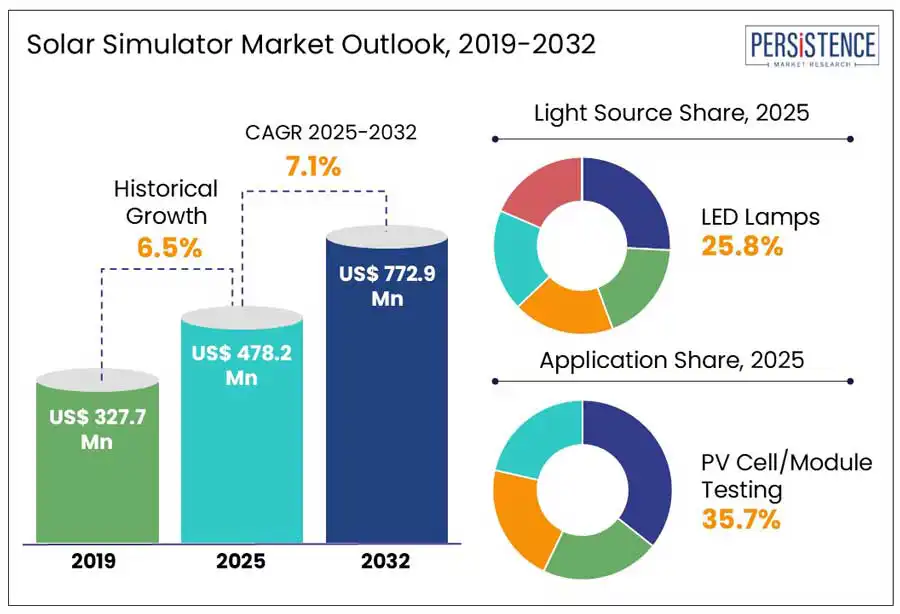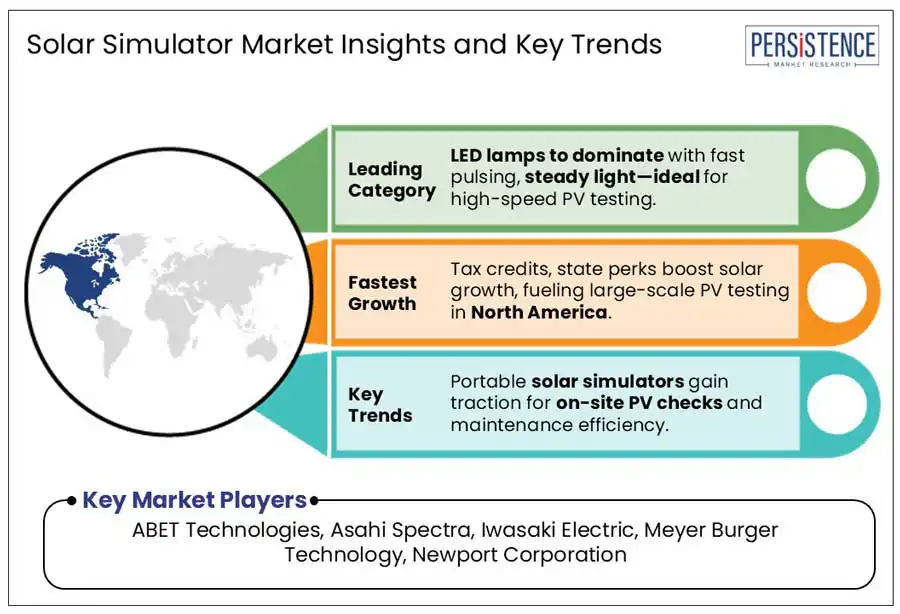ID: PMRREP33597| 160 Pages | 15 Apr 2025 | Format: PDF, Excel, PPT* | Energy & Utilities

The global solar simulator market size is projected to rise from US$ 478.2 Mn in 2025 to US$ 772.9 Mn by 2032. It is anticipated to witness a CAGR of 7.1% during the forecast period from 2025 to 2032.
Solar simulators create a regulated environment indoors for evaluating polymers, solar cells, and other materials and devices across various industries in laboratory settings and is envisioned to propel demand. Increasing investment by government bodies in research and development activities to enhance the efficiency of solar energy-based products is also expected to boost demand.

Key Industry Highlights
|
Global Market Attribute |
Key Insights |
|
Solar Simulator Market Size (2025E) |
US$ 478.2 Mn |
|
Market Value Forecast (2032F) |
US$ 772.9 Mn |
|
Projected Growth (CAGR 2025 to 2032) |
7.1% |
|
Historical Market Growth (CAGR 2019 to 2024) |
6.5% |
Increasing inclination of various industries toward renewable energy is anticipated to be a key market driver. Several countries have set up new goals to achieve carbon neutrality, such as the European Union’s (EU) aim to obtain net-zero emissions by 2050. India is also focusing on achieving 500 GW of non-fossil fuel capacity by 2030. Hence, demand for high-performance, reliable, and efficient solar panels has skyrocketed.
Solar simulators are considered significant devices that can offer repeatable, controlled light sources for the testing of solar panels and cells under laboratory supervision. These devices help in ensuring product quality, boosting research activities and accelerating certification processes. The International Energy Agency (IEA) mentioned that in 2023, the total solar photovoltaic (PV) capacity additions globally surged by 26%, reaching 380 GW. It will likely propel demand for novel testing equipment such as PV array simulators.
Even though solar PV simulators are showcasing steady demand worldwide, high cost of certain innovative models, mainly those belonging to class AAA hinders demand. These devices require rigorous calibration, precision optics, and complex lamp systems to achieve the desired spectral uniformity and match.
A sophisticated class AAA simulator is usually priced between US$ 30,000 and US$ 100,000, depending on the testing area and specifications. It is projected to become a challenge for mid- and small-sized research laboratories or solar product manufacturers with limited resources to acquire these devices.
Large area pulsed solar simulators are poised to be demanded across non-conventional solar markets, specifically agrivoltaics and Building-Integrated Photovoltaics (BIPV). These are the key sectors that are constantly evolving and hence require personalized light simulation capabilities as well as testing environments. As BIPV integrates solar elements directly into the architectural aspects of buildings, simulators are considered important to replicate irregular irradiance levels, multiple incident angles, and diffuse sunlight.
Agrivoltaic systems, on the other hand, utilize bifacial or semi-transparent solar panels. These operate under highly dynamic and diffused light conditions spurred by cloud movement, time of day, panel tilt, and plant height. Solar simulators are estimated to be used to test these panels in the laboratory to find out whether these are capable of varying light spectrum and intensity. This is envisioned to help researchers predict the photosynthetic influence on crops as well as energy efficiency.
The emergence of tandem and bifacial solar cells is projected to be a key trend in the market. Bifacial cells have gained impetus due to their ability to provide high energy yields. Compared to monofacial modules, these offer 10 to 20% more yields according to installation design and albedo. As per the International Technology Roadmap for Photovoltaic (ITRPV), in 2023, bifacial modules accounted for more than 40% of PV shipments globally. Hence, development of dual-side solar simulators is speculated to surge to improve measurement accuracy of bifacial solar cells.
Tandem solar cells, on the other hand, often stack several layers of semiconductor. Solar simulators are poised to offer precise multi-spectral tuning features to accurately measure the degradation and efficiency of each sub-cell in tandem modules. Companies such as Haleon Solar and G2V Optics, for example, recently introduced LED-based simulators equipped with individually controllable channels to allow for independent tuning in narrow spectral bands.
Based on light source, the market is divided into xenon arc lamps, metal halide arc lamps, LED lamps, and UV lamps. Among these, LED lamps are projected to generate a solar simulator market share of about 25.8% in 2025. These lamps are highly preferred due to their long operational lifespan, high energy efficiency, and excellent spectral control. These properties help in addressing the major drawbacks of conventional metal halide and xenon arc lamps such as high energy consumption and long warm-up periods.
UV lamps, on the other hand, are estimated to show decent growth in the forecast period as these help mimic the ultraviolet area of the solar spectrum. These are considered significant for scrutinizing degradation behavior and long-term durability of PV materials.
In terms of application, the market is segregated into PV cell/module testing, UV testing of materials and products, and automotive testing. Out of these, PV cell/module testing is expected to account for nearly 35.7% share in 2025. It is attributed to the ability of simulators to deliver artificial light, replicating the AM1.5G solar spectrum. It enables researchers to evaluate significant electrical parameters such as efficiency, open-circuit voltage, and fill factor. These parameters are considered important for binning modules and cells for market pricing and quality assurance.
UV testing of materials and products is another key application as UV radiation has a significant impact on material degradation. UV exposure simulation is required to estimate the long-term stability and reliability of products utilized outdoors such as adhesives, solar modules, paints, and automotive components.

North America is predicted to generate a share of around 31.6% in 2025, finds Persistence Market Research. This is attributed to supportive federal norms promoting clean energy adoption and ongoing expansion of solar PV production. The U.S. solar simulator market is envisioned to remain at the forefront with rising domestic production of solar energy.
The Solar Energy Industries Association (SEIA) revealed that by 2026, the total solar manufacturing capacity in the U.S. is anticipated to surpass 60 GW, up from 7.5 GW achieved in 2022. This high production capacity will likely demand the deployment of solar simulators that comply with updated IEC 60904-9:2020 standards. Several local companies such as First Solar, Qcells, and LONGiv have started extending their plants across Texas, Ohio, and Georgia to integrate simulators into their manufacturing lines to meet performance requirements.
China is estimated to spearhead countries such as Japan and South Korea in Asia Pacific through 2032. The country houses a well-established solar manufacturing infrastructure. More than 600 GW of solar modules were produced in China in 2023, which represented over 75% of global supply. This high volume is anticipated to propel the requirement for constant testing at every step, right from wafers and ingots to final modules and cells. It will likely bolster the adoption of solar simulators across tier 1 manufacturing companies in the country.
In Japan, companies such as Asahi Spectra, EKO Instruments, and Hamamatsu Photonics are focusing on producing class AAA simulators with high accuracy for use in specialized PV testing as well as semiconductor research. South Korea, on the other hand, is poised to exhibit considerable growth as manufacturers are investing in the development of high-efficiency modules. Korea Institute of Energy Research (KIER) and LG Energy Solution, for instance, are accelerating next-generation cell architectures such as perovskite-silicon tandems.
In Europe, France is speculated to lead in the foreseeable future due to increasing investments in PV testing and development, specifically those related to recyclable and sustainable technologies. The National Institute for Solar Energy plays a key role in solar research work in France. By 2027, as part of the France 2030 initiative, the country plans to quadruple its total domestic solar manufacturing capacity. The initiative includes an allocation of €1 Bn for solar power testing and innovation infrastructure.
Germany is presumed to exhibit a steady growth rate through 2032, backed by its robust research and development infrastructure that exhaustively uses simulators. Germany-based Fraunhofer Institute for Solar Energy Systems ISE, considered one of the most prominent across Europe, uses class AAA simulators to work on floating solar, bifacial modules, and tandem cells. The institute’s CalLab PV Cells facility ensures to test cells regularly to achieve efficiencies above 29%.
The global solar simulator market is still at the nascent stage with the presence of a handful of key players. They are focusing on launching innovative simulators to extend their application areas. A few educational institutions are conducting in-depth research and development activities to come up with novel simulators so that new materials can be tested in varying environments.
The global market is projected to be valued at US$ 478.2 Mn in 2025.
Increasing shift of industries toward renewable energy and emergence of bifacial solar cells are the key market drivers.
The market is poised to witness a CAGR of 7.1% from 2025 to 2032.
Development of agrivoltaic systems and government incentives to support solar energy adoption are the key market opportunities.
ABET Technologies, Asahi Spectra, and Iwasaki Electric are among leading key players.
|
Report Attribute |
Details |
|
Historical Data/Actuals |
2019 - 2024 |
|
Forecast Period |
2025 - 2032 |
|
Market Analysis Units |
Value: US$ Bn/Mn, Volume: As Applicable |
|
Geographical Coverage |
|
|
Segmental Coverage |
|
|
Competitive Analysis |
|
|
Report Highlights |
|
|
Customization and Pricing |
Available upon request |
By Light Source
By Dimension
By Application
By Industry
By Region
Delivery Timelines
For more information on this report and its delivery timelines please get in touch with our sales team.
About Author